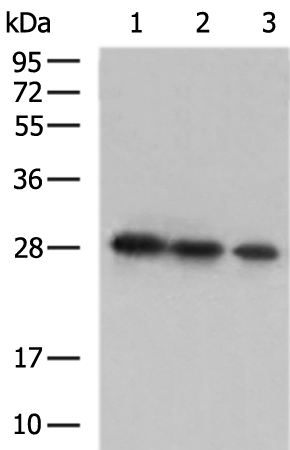
| WB | 咨询技术 | SARS-CoV-2/2019-nCoV、Virus |
| IF | 咨询技术 | SARS-CoV-2/2019-nCoV、Virus |
| IHC | 咨询技术 | SARS-CoV-2/2019-nCoV、Virus |
| ICC | 技术咨询 | SARS-CoV-2/2019-nCoV、Virus |
| FCM | 咨询技术 | SARS-CoV-2/2019-nCoV、Virus |
| Elisa | 1/5000-1/10000 | SARS-CoV-2/2019-nCoV、Virus |
| Aliases | COVID-19; 2019-nCoV; SARS-CoV-2; spike glycoprotein; 新型冠状病毒; 新冠病毒 |
| WB Predicted band size | 24 kDa |
| Host/Isotype | Rabbit IgG |
| Antibody Type | Primary antibody |
| Storage | Store at 4°C short term. Aliquot and store at -20°C long term. Avoid freeze/thaw cycles. |
| Species Reactivity | SARS-CoV-2/2019-nCoV、Virus |
| Immunogen | Fusion protein corresponding to a region derived from 805-1020 amino acids of SARS-CoV-2 S protein |
| Formulation | Purified antibody in PBS with 0.05% sodium azide and 50% glycerol. |
+ +
以下是3篇关于SARS-CoV-2 S2抗体的代表性文献及其摘要概括:
1. **文献名称**: *Cross-neutralization of SARS-CoV-2 by a human monoclonal SARS-CoV antibody*
**作者**: Pinto D. et al.
**摘要**: 该研究发现,靶向S2亚基上高度保守的融合肽区域的单克隆抗体(如S2P6)可交叉中和SARS-CoV-2和SARS-CoV,并在小鼠模型中验证了其对病毒复制的抑制能力,提示S2抗体可能提供广谱保护。
2. **文献名称**: *Broad betacoronavirus neutralization by a stem helix–specific human antibody*
**作者**: Tortorici M.A. et al.
**摘要**: 通过结构生物学分析,揭示了一种靶向S2茎螺旋区(stem-helix)的人源抗体(如SARS2-38),可中和多种β冠状病毒(包括SARS-CoV-2变体),并解析了其通过阻断病毒膜融合发挥作用的机制。
3. **文献名称**: *A human antibody reveals a conserved site on beta-coronavirus spike proteins and confers protection against SARS-CoV-2 infection*
**作者**: Zost S.J. et al.
**摘要**: 该研究从康复者中分离出靶向S2亚基七肽重复区(HR1)的抗体(如CV3-25),证明其可中和SARS-CoV-2及其变体,并在仓鼠模型中减少肺部病毒载量,强调了S2表位在疫苗设计中的潜力。
4. **文献名称**: *Antibody cocktail effective against variants of SARS-CoV-2*
**作者**: Cao Y. et al.
**摘要**: 研究组合了靶向S1和S2的双抗体疗法(如BD-368-2和S2抗体BD-604),在体外和动物模型中显示对Alpha、Beta等变异株的协同中和效果,表明S2抗体可增强现有疗法的抗病毒广度。
这些研究共同表明,S2抗体通过靶向高度保守的融合相关表位(如茎螺旋、HR1等),在广谱中和及应对病毒进化中具有重要价值,为通用冠状病毒疫苗和抗体药物研发提供了方向。
SARS-CoV-2 S2 antibodies target the conserved S2 subunit of the viral spike (S) protein, which plays a critical role in membrane fusion during host cell entry. The S protein is divided into S1 (responsible for receptor binding) and S2 (mediating fusion). Unlike the hypervariable S1 subunit, particularly the receptor-binding domain (RBD), the S2 subunit is more conserved across SARS-CoV-2 variants and related coronaviruses, making it a potential target for broad-spectrum therapeutics and vaccines. S2-directed antibodies often recognize epitopes in the stalk region, fusion peptide (FP), or heptad repeat (HR) domains, which are less prone to immune evasion mutations.
Research suggests that S2 antibodies may neutralize the virus by blocking conformational changes required for membrane fusion or through Fc-mediated effector functions like antibody-dependent cellular cytotoxicity (ADCC). Although most vaccine and antibody therapies focus on S1/RBD due to potent neutralization, S2-specific antibodies have gained attention for their potential to confer cross-protection against emerging variants (e.g., Omicron) and even other sarbecoviruses. However, S2 antibodies generally exhibit weaker neutralizing potency compared to RBD-targeting ones, necessitating strategies to enhance their efficacy. Recent studies have identified several S2-specific monoclonal antibodies (e.g., COV2-3432) and explored S2-based vaccine candidates in preclinical models. Challenges remain in optimizing immunogenicity and balancing cross-reactivity with specificity. Overall, S2 antibodies represent a promising avenue for developing pan-coronavirus countermeasures.
×